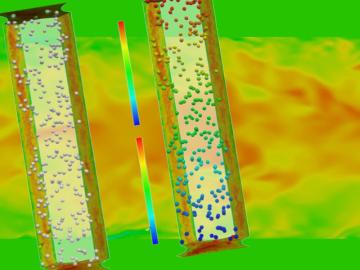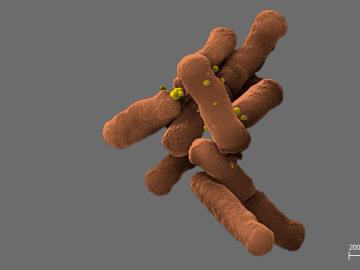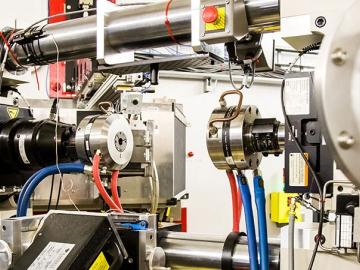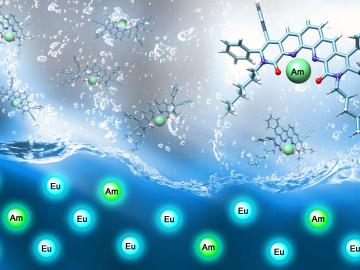
Filter News
Area of Research
- Advanced Manufacturing (7)
- Biological Systems (2)
- Biology and Environment (21)
- Building Technologies (2)
- Clean Energy (118)
- Climate and Environmental Systems (4)
- Computational Biology (1)
- Computer Science (2)
- Energy Frontier Research Centers (1)
- Energy Sciences (1)
- Fossil Energy (1)
- Fuel Cycle Science and Technology (1)
- Fusion and Fission (6)
- Fusion Energy (6)
- Isotopes (5)
- Materials (104)
- Materials for Computing (5)
- National Security (16)
- Neutron Science (54)
- Nuclear Science and Technology (36)
- Nuclear Systems Modeling, Simulation and Validation (3)
- Quantum information Science (3)
- Sensors and Controls (2)
- Supercomputing (61)
Date
News Topics
- 3-D Printing/Advanced Manufacturing (46)
- Advanced Reactors (18)
- Artificial Intelligence (31)
- Big Data (22)
- Bioenergy (25)
- Biology (18)
- Biomedical (30)
- Biotechnology (7)
- Buildings (14)
- Chemical Sciences (19)
- Clean Water (6)
- Climate Change (31)
- Composites (8)
- Computer Science (73)
- Coronavirus (23)
- Critical Materials (7)
- Cybersecurity (7)
- Decarbonization (22)
- Education (1)
- Emergency (1)
- Energy Storage (32)
- Environment (51)
- Exascale Computing (8)
- Fossil Energy (3)
- Frontier (7)
- Fusion (23)
- Grid (17)
- High-Performance Computing (17)
- Isotopes (25)
- ITER (1)
- Machine Learning (17)
- Materials (16)
- Materials Science (62)
- Mathematics (5)
- Mercury (2)
- Microelectronics (1)
- Microscopy (15)
- Molten Salt (6)
- Nanotechnology (28)
- National Security (17)
- Net Zero (6)
- Neutron Science (48)
- Nuclear Energy (51)
- Partnerships (12)
- Physics (26)
- Polymers (17)
- Quantum Computing (10)
- Quantum Science (29)
- Security (12)
- Simulation (13)
- Space Exploration (7)
- Statistics (2)
- Summit (23)
- Sustainable Energy (41)
- Transformational Challenge Reactor (5)
- Transportation (34)
Media Contacts

It may take a village to raise a child, according to the old proverb, but it takes an entire team of highly trained scientists and engineers to install and operate a state-of-the-art, exceptionally complex ion microprobe. Just ask Julie Smith, a nuclear security scientist at the Depa...

The intrinsic beauty of bubbles—those thin watery spheres filled with air or other gases—has long captured the imagination of children and adults alike. But bubbles are also a linchpin of nuclear engineering, helping to explain the natural world, predict safety issues and improve the...

Having begun her career at the lab in the nuclear nonproliferation and radiation safeguards area, Shaheen Dewji is leveraging her expertise to help expand the work of the Center for Radiation Protection Knowledge (CRPK)—a unique organization led by Oak Ridge National Laboratory that ...

Oak Ridge National Laboratory today welcomed a second group of technology innovators to join Innovation Crossroads, the Southeast’s only entrepreneurial research and development program based at a U.S. Department of Energy national laboratory. Selected through a me...

An Oak Ridge National Laboratory-led team cultivated a novel oral microbe, Desulfobulbus oralis, present in adults with periodontitis, an advanced gum disease that affects nearly half of all adults worldwide.

Oak Ridge National Laboratory has partnered with FCA US LLC and casting manufacturer Nemak to develop a new cast aluminum alloy for engine cylinder heads, which could lead to more fuel-efficient internal combustion engines.
Scientists at Oak Ridge National Laboratory have conducted a series of breakthrough experimental and computational studies that cast doubt on a 40-year-old theory describing how polymers in plastic materials behave during processing.

James Peery, who led critical national security programs at Sandia National Laboratories and held multiple leadership positions at Los Alamos National Laboratory before arriving at the Department of Energy’s Oak Ridge National Laboratory last year, has been named a...




